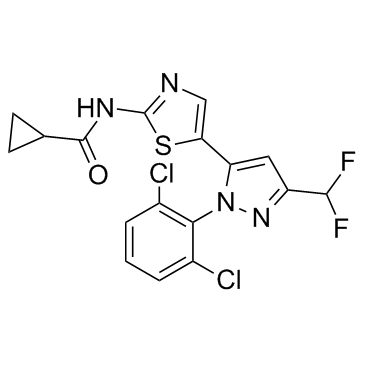1338247-30-5
| Name | N-[5-[2-(2,6-dichlorophenyl)-5-(difluoromethyl)pyrazol-3-yl]-1,3-thiazol-2-yl]cyclopropanecarboxamide |
|---|---|
| Synonyms |
Cyclopropanecarboxamide, N-[5-[1-(2,6-dichlorophenyl)-3-(difluoromethyl)-1H-pyrazol-5-yl]-2-thiazolyl]-
N-(5-(1-(2,6-dichlorophenyl)-3-(difluoromethyl)-1H-pyrazol-5-yl)thiazol-2-yl)cyclopropanecarboxamide RS0050 N-{5-[1-(2,6-Dichlorophenyl)-3-(difluoromethyl)-1H-pyrazol-5-yl]-1,3-thiazol-2-yl}cyclopropanecarboxamide BMS-3 |
| Description | BMS-3 is a potent LIMK inhibitor with IC50s of 5 nM and 6 nM for LIMK1 and LIMK2, respectively. |
|---|---|
| Related Catalog | |
| Target |
LIMK1:5 nM (IC50) LIMK2:6 nM (IC50) |
| In Vitro | BMS-3 (Compound 2) causes a dose-dependent reduction in cell count and induces mitotic arrest by increases in total nuclear DNA intensity and histone H3 phosphorylation after 24 h treatment in A549 human lung cancer cells. BMS-3 inhibits A549 human lung cancer cells with EC50 value of 154 nM[1]. BMS-3 is used to demonstrate the direct participation of LIMK1 in the phosphorylation of Cofilin. Inhibition of p-LIMK with 1-50 μM of BMS-3 results in a dose-dependent decrease of p-Cofilin after 10 min incubation in capacitating conditions. As a control, sperm are also incubated for 10 min under non-capacitating conditions which result in low levels of p-Cofilin. In the presence of 1 or 50 μM of BMS-3, actin polymerization levels are significantly lower compared to controls (DMSO). Mouse sperm are incubated under capacitating conditions for 90 min in the presence or absence of increasing concentrations of p-LIMK inhibitor BMS-3 (0, 1, 10 and 50 μM). The increasing concentrations of BMS-3 result in a strong decrease on the percentage of sperm that undergoes acrosomal exocytosis after stimulation with 20 μM of Progesterone[2]. |
| Kinase Assay | The protein kinase domains of human LIMK1 and LIMK2 are expressed as glutathione S-transferase fusion proteins using the Bac-to-Bac system in Sf9 cells. Compounds 1 to 6 (e.g., BMS-3) are assayed for inhibition of LIMK1 and LIMK2 protein kinase activity by radioactive phosphate incorporation into biotinylated full-length human destrin. Reactions are done with a concentration series of compound in 25 mM HEPES, 100 mM NaCl, 5 mM MgCl2, 5 mM MnCl2, 1 μM total ATP, 83 μg/mL biotinylated destrin, 167 ng/mL glutathione S-transferase-LIMK1, or 835 ng/mL glutathione S-transferase-LIMK2 in a total volume of 60 μL at room temperature for 30 min (LIMK1) or 60 min (LIMK2). Reactions are terminated by addition of 140 μL of 20% TCA/100 mM sodium pyrophosphate, and the precipitates are harvested onto GF/C unifilter plates. The radioactivity incorporated is determined using a TopCount after addition of 35 μL Microscint scintillation fluid[1]. |
| References |
| Density | 1.7±0.1 g/cm3 |
|---|---|
| Molecular Formula | C17H12Cl2F2N4OS |
| Molecular Weight | 429.271 |
| Exact Mass | 428.007690 |
| PSA | 91.54000 |
| LogP | 5.46 |
| Index of Refraction | 1.733 |
| Storage condition | 2-8℃ |
